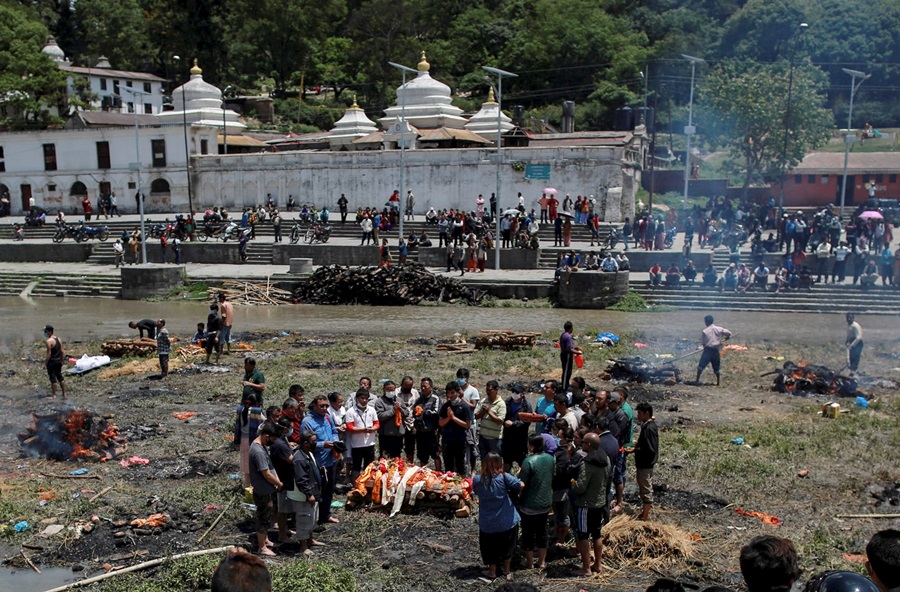Nepal Exodus Begins as Thousands Flee Quake-Ravaged Capital Amid Aftershocks; Over 3,700 Dead

Thousands of terror-stricken people began an exodus out of the earthquake-ravaged Nepali capital of Kathmandu on Monday seeking safety elsewhere after two days of powerful aftershocks amid dwindling supply of food and water.
The death toll from Saturday's 7.8 magnitude quake was estimated at more than 3,700 as of Monday with officials fearing the toll could reach up to 5,000. It was the worst earthquake to hit Nepal since 1934. More than 6,500 were injured.
People jammed the roads leading out of Kathmandu, some carrying babies as they boarded buses and other vehicles.
The city's Tribhuvan International Airport was crowded with tourists and residents desperately seeking to fly out of the devastated Nepali capital.
Many of the city's one million residents have been sleeping out in the open since Saturday after the earthquake destroyed their homes. Many of them are sick and wounded who could not be accommodated anymore in the city's ruined hospitals. At Kathmandu Medical College, surgeons have set up an operating theater inside a tent outside the campus.
Nepal's government faces gargantuan problems as authorities try to deliver food and drinking water to as many survivors as possible even as they try to prevent diseases and restore electricity. The government has been crying out for international help since Saturday.
"The big challenge is relief," Chief Secretary Leela Mani Paudel, Nepal's top bureaucrat, said Monday. "We urge foreign countries to give us special relief materials and medical teams. We are really desperate for more foreign expertise to pull through this crisis," she added.
At Mount Everest, hundreds of climbers stayed at their base camp after a huge avalanche triggered by the quake killed 17 of their colleagues on Saturday – the biggest disaster to hit the area. Rescuers have been using helicopters to airlift climbers stranded on the slopes of the world's highest mountain.
The United Nations Children's Fund said nearly one million children in Nepal were severely affected by the quake, and warned of waterborne and infectious diseases. "This crisis leaves children particularly vulnerable -- limited access to safe water and sanitation will put children at great risk from waterborne diseases, while some children may have become separated from their families," the UNICEF said.
In the ancient temple town of Bhaktapur, east of Kathmandu, many residents were living in tents in a school compound after centuries old buildings collapsed or developed huge cracks.
"We have become refugees," said Sarga Dhaoubadel, a management student whose ancestors had built her Bhaktapur family home over 400 years ago.
They were subsisting on instant noodles and fruit, she said. "No one from the government has come to offer us even a glass of water," she said. "Nobody has come to even check our health. We are totally on our own here. All we can hope is that the aftershocks stop and we can try and get back home."
Neighboring countries were quick to dispatch aid and personnel to help in rescue efforts. India sent helicopters, medical supplies and trained rescue workers. China likewise sent a 60-strong emergency team. Pakistan said it was sending four C-130 aircraft with a 30-bed hospital.
The U.S. is sending a military aircraft with 70 personnel. Britain, Australia and New Zealand likewise pledged to send rescue teams to Kathmandu. Several hundred British nationals were said to be in Nepal when disaster struck.
Despite pledges of assistance from various countries, there were little signs of such foreign aid on the ground in Kathmandu. Some airplanes carrying supplies and rescue workers tried to land at Kathmandu airport on Sunday, but authorities closed the airport immediately after aftershocks shook the ground.
On Monday, an Indian military relief plane turned back after it failed to land at the airport due to congestion, according to an Indian television report.
The disaster underscored the miserable state of Nepal's medical facilities. The small Himalayan country only has a ration of 2.1 physicians and 50 hospital beds for every 10,000 people, according to a 2011 World Health Organization report.
The U.S. Embassy in Kathmandu said cell phone and Internet services are intermittent.
The U.S. government has pledged an initial $1 million in humanitarian assistance to Nepal following U.S. Ambassador to Nepal Peter Bodde's disaster declaration.





